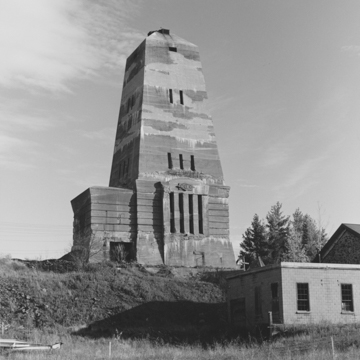You are here
Cliffs Shaft Mining Museum (Cliffs Shaft Mine Headframes)
In the prominently located headframes for the A and B shafts of the Cliffs Shaft Mine of the Cleveland-Cliffs Iron Mining Company (in 1919 the largest producer of hard hematite ore on the Marquette Iron Range), the company's president, William G. Mather, sought to combine architectural beauty with practicality. He achieved this through the collaboration of the Condron Company, structural engineers in Chicago, with Maher, a Chicago School architect of considerable reputation. This joint effort resulted in these remarkable reinforced-concrete obelisks. Their blunt profiles and austere geometry make it difficult to escape the notion that architect Maher still had fresh in his mind H. H. Richardson's renowned Ames Monument in Sherman, Wyoming. With no interruption in the use of the hoist, the headframes were constructed around existing wooden headframes dating from the sinking of the mines in the 1870s. The hoisting ropes were changed over on successive weekends and the old wooden structures dismantled. The operational use of the pair was replaced by the C shaft in 1955. In 1998 CCI donated the property to the Marquette Range Iron Mining Heritage Theme Park, which operates the Cliffs Shaft Mining Museum.
Writing Credits
If SAH Archipedia has been useful to you, please consider supporting it.
SAH Archipedia tells the story of the United States through its buildings, landscapes, and cities. This freely available resource empowers the public with authoritative knowledge that deepens their understanding and appreciation of the built environment. But the Society of Architectural Historians, which created SAH Archipedia with University of Virginia Press, needs your support to maintain the high-caliber research, writing, photography, cartography, editing, design, and programming that make SAH Archipedia a trusted online resource available to all who value the history of place, heritage tourism, and learning.


